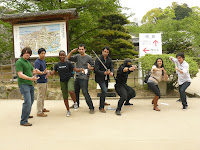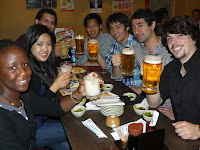On Monday, we woke up early to make our 8 AM train to Himeji. For those of you unfamilar with Japan's geography, a train trip from Tokyo to Himeji actually makes a stop in Kyoto. We were taking full advantage of our unlimited use one week JR passes!
 |
| The best view we ended up having of Himeji Castle. |

 We visited Himeji to see the famous Himeji Castle, known for being one of the best preserved, and grandest castles of the 12 remaining in Japan. To stay well preserved, the castle must undergo renovations every 50 years, with a major renovation every 100. It was just our luck that Himeji was undergoing one such renovation, and will not finish until 2015! Instead of seeing the beautiful white curved tile tiered roofs that Japanese castles are renoun for, we were greeted by a large white box, with an outlined image of the castle printed upon in. Despite these setbacks, we were still able to walk around the grounds, view the interior of some of the smaller towers, and take some pictures with some Japanese dressed in "traditional" garb.
We visited Himeji to see the famous Himeji Castle, known for being one of the best preserved, and grandest castles of the 12 remaining in Japan. To stay well preserved, the castle must undergo renovations every 50 years, with a major renovation every 100. It was just our luck that Himeji was undergoing one such renovation, and will not finish until 2015! Instead of seeing the beautiful white curved tile tiered roofs that Japanese castles are renoun for, we were greeted by a large white box, with an outlined image of the castle printed upon in. Despite these setbacks, we were still able to walk around the grounds, view the interior of some of the smaller towers, and take some pictures with some Japanese dressed in "traditional" garb.However, the true highlight of our visit to Himeji, and possibly of our entire Golden Week trip, were the Himeji Gardens. A huge complex consisting of multiple tea houses, a kimono display, 7 large gardens, nurseries, and more, we spent a couple hours leisurely wandering the garden until we were politely asked to leave by some guards :) A couple of my friends even napped a bit in the wooden decks throughout the gardens.
While the day wasn't what we expected, it was a nice peaceful followup to our jam-packed days in Tokyo, and the gardens were truly spectacular.
 |
| 360 degree view of the seventh garden |






































